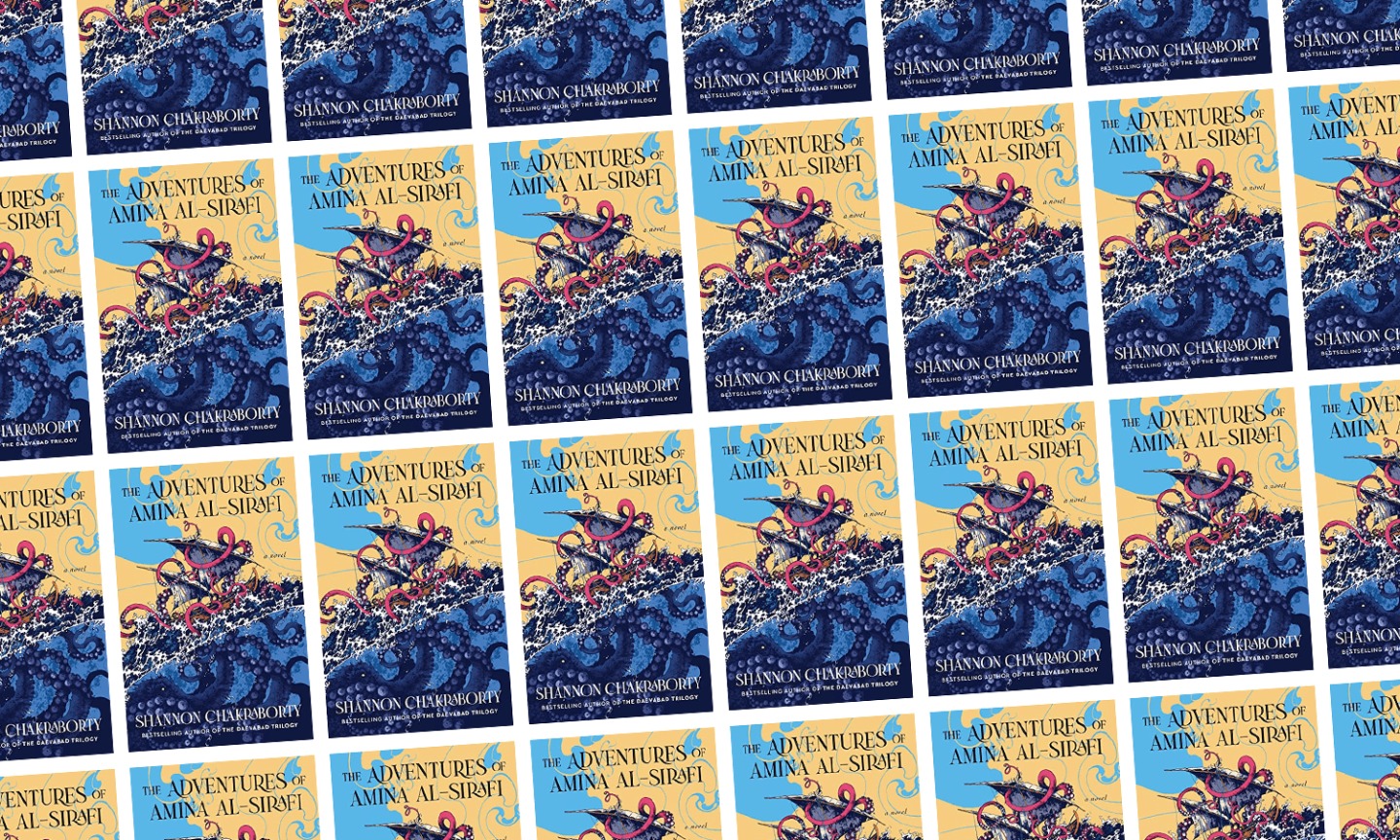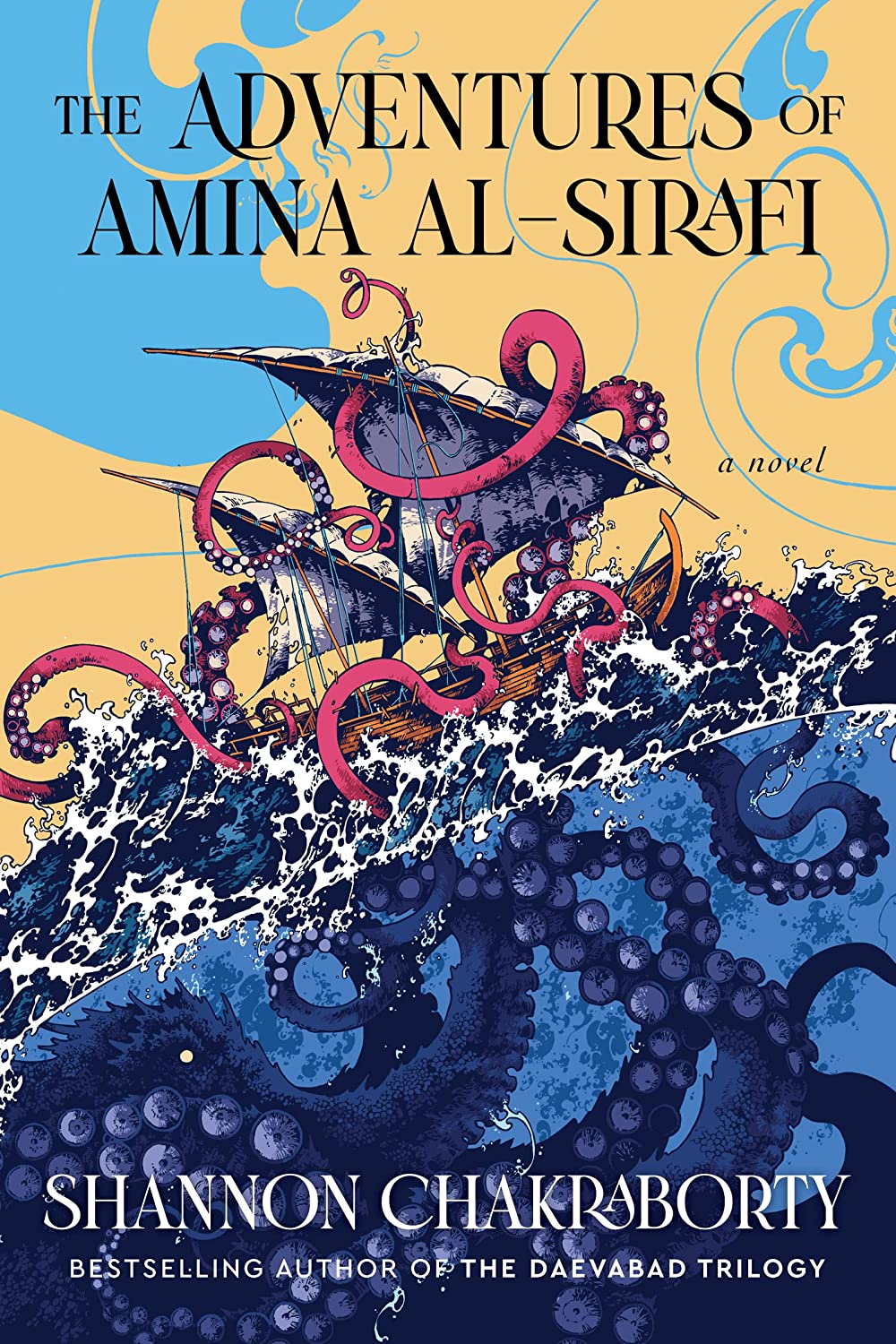
Unusual Pirate Tales: The Adventures of Amina Al Sirafi by Shannon Chakraborty
There’s nothing like a swashbuckling story set on the high seas, and Shannon Chakraborty’s The Adventures of Amina Al-Sirafi is one such tale. If you enjoy this type of story, then it is well worth reading. It is also worth a read if you’ve been overwhelmed by pirate stories published in the past. Chakraborty’s book is set in the magical 12th century Indian Ocean, which is not the usual setting for famous pirate stories, such as those we’ve seen from Walt Disney Studios. Amina, the book’s protagonist, is not your typical nakhudha (captain). She is a formidable, brave middle-aged woman who, frankly, at this point in her career, dresses a little poorly.
At the beginning of the novel, Amina has retired and is living a peaceful life with her mother and daughter. She misses the sea, but she left her beloved ship, the Malawati, because her demonic husband (Amina had had multiple husbands in her life at the time, and some marriages lasted only a night or two) caused an accident that destroyed the souls of her crew. It was an ill-fated deal. The trauma of this unnatural death scarred Amina and the rest of her surviving crew, who all disbanded after locking her chaos-seeking lover in a crate and leaving him to die. For the past decade, Amina has been living an incognito life on land.
However, Amina’s saga as the mighty Nakuda continues, and her identity as a troubled tour guide is revealed after she saves two patrons from some kind of supernatural death. The story reaches the wealthy mother of her deceased crew member. The woman hunts down Amina and convinces the ex-Nahuda to rescue her granddaughter, who has allegedly eloped with a magically meddling Frank from what is now known as Italy. The promise of a generous payment initially motivates Amina, with a broken knee, to get her crew and her ship back—though not without taking risks, and once they hunt down Frank, into a massive (literally) and life-threatening battle that could harm hundreds, if not thousands.
Amina’s story, told in the first person to the scribe, conveys what an adventure story should be: with monsters and magical items, people in need of rescue, and people with multiple motives. Chakraborty is inspired by travelogues and fantasy literature of the medieval Islamic world, and the themes and magic clearly reflect this. For example, throughout the book, there are episodes in which Amina, through the scribe to whom she is telling the story, narrates a long-held story about a creature trapped in a basin that was granted unspeakable powers (spoiler alert: that object was something Frank wanted for nefarious purposes, and Amina had to stop him from obtaining it to prevent thousands of deaths).
However, “The Adventures of Amina al-Sirafi” is also a story about a middle-aged mother who wants to protect her child the most.
“The perception of mothers is that we are tender, soft, sweet,” Amina says at the beginning of the book, as the wealthy grandmother subtly threatens her child. “It was like the moment my daughter was lying on my chest, the words ‘I would do anything’ didn’t reach a depth I had never understood before. This woman actually wanted to break into my house in front of my child and threaten my family? She must have not heard the correct story about Amina Sirafi.”
As a parent of a certain age, I resonate with this about Amina—the fervent love for kids, the challenge of work-life balance (Corsair is not an ideal place for a 10-year-old, although Amina Mina, of course, misses her daughter a lot, although she is happy to be back in Malawati doing a career she loves) and recognizing that your physical abilities, such as that injured knee, are not what they used to be. Amina is older, but she can still fight, still full of fighting spirit and determination. I hope we see more characters like her in genre fiction in the years to come.
Like many pirate tales, The Adventures of Amina Sirafi turns dark, full of graphic violence and gruesome death. However, there are light moments in the novel, including some rather humorous ones, especially when Amina’s demonic husband reappears. His egocentricity creates comical scenes, even when they’re surrounded by destruction, potential tragedy, or other apparently hopeless circumstances.
The crew is a joy, too: Dalila with her lot of poison and steely determination; Thimphu with her big heart and unwavering loyalty; irritability will disappear. Everyone in the cast also comes from a different place, with different interests, histories, and directions, which add depth and emotion to the events they’re in.
Last but not least, of course, is Malawati’s lame excusefor cats, a stray cat who can’t help but steal your heart with every meow.
While things get really magical and eccentric in the second half of the book (perhaps a little too eccentric, though your mileage may vary), Amina’s relationship with her crew and her love for her daughter keep the story from going off the rails (sorry, I couldn’t help myself). The end of the book also provides an opportunity for further adventures for Amina Sirafi and her crew. Personally, I’m eagerly anticipating the next installment, which will hopefully be part of a series of multiple adventures.








Tagged "The Light at the End of the World", Historical Fiction, nationalism, Siddhartha Deb, social upheaval